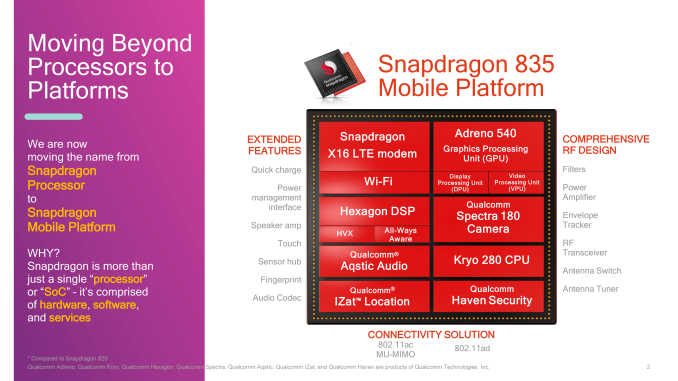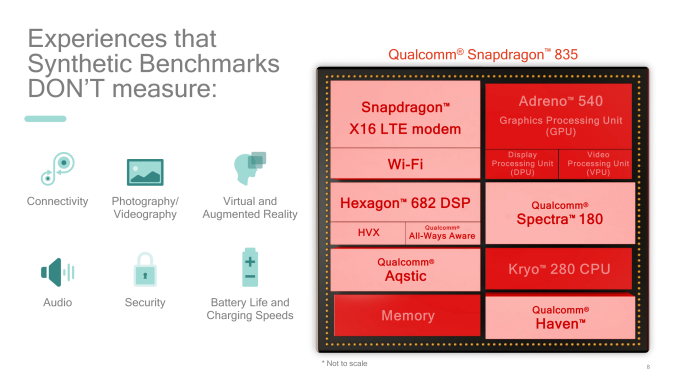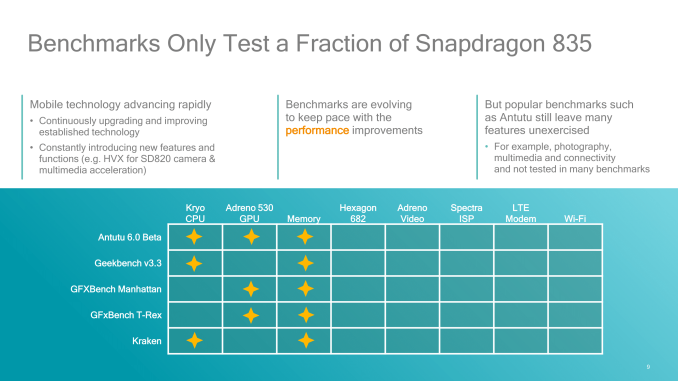The Qualcomm Snapdragon 835 Performance Preview
by Matt Humrick & Ryan Smith on March 22, 2017 4:30 AM EST- Posted in
- Smartphones
- Snapdragon
- Qualcomm
- Mobile
- SoCs
- Snapdragon 835
- Kryo
Qualcomm's Thoughts on Benchmarks versus End-User Experiences
While the primary purpose of our visit out to Qualcomm’s offices was for benchmarking, for this year’s event Qualcomm went one step further and invited us to take a tour of some of their labs. The tour itself was plenty interesting (more on this in a bit), however arguably the more important aspect of the tour isn’t what we saw, but why Qualcomm is giving the press lab tours after so long. A tour may sound trite, but for Qualcomm it’s a sign of bigger things.
Perhaps the most important thing to understand about Qualcomm is that while the bulk of the company’s revenue comes from chips, the majority of their actual profits come from various technology and patent licensing programs. The actual breakdown between the two halves of Qualcomm gets a bit weird when trying to best account for which half foots the bill for R&D, but at the end of the day it’s Qualcomm’s licensing business that is making them the most money.
| Qualcomm Financials (FY'2016) | ||||
| Chip-Making | Licensing | |||
| Revenue | $15.4B | $7.6B | ||
| Profit (Pretax) | $1.8B | $6.5B | ||
As a result, if boardroom-level rumors are to be believed, the company is never quite sure how to balance the two businesses. Some groups want licensing and chip design separated, and others want them to stay combined. Qualcomm seems content to stick with the status quo and their $5.7B in profits for 2016, but as a consequence of this unusual split it means that the chip side of Qualcomm is always under a bit of pressure to prove itself.
The good news for the chip business is that it’s doing fairly well, especially in North America. Most high-end Android smartphones sold in the US are based on Qualcomm’s chips, Qualcomm’s modems are in some (but no longer all) of Apple’s iPhone SKUs, and even in the midrange market Qualcomm’s Snapdragon 600 series chips are in a number of popular phones. The flip side of this is that outside of the US and especially outside of the high-end, Qualcomm’s chip business is under constant pressure from both their partners and their competitors. Samsung is happy to stick with their own home-grown Exynos chips outside of North America, and other chip vendors like MediaTek nip at Qualcomm’s heels with competent midrange SoCs that are priced very aggressively. So while Qualcomm’s chip business is doing well right now, that could very well change in the future.
But what does this have to do with a press tour of their labs? One of the big initiatives for Qualcomm, as exemplified in last week’s Snapdragon branding tweak, is that the chip arm of the company wants to get away from being so frequently judged on the basis of their CPU and only their CPU. This is why Snapdragon is now a platform versus a processor, and similarly, it’s why we’re going to see Qualcomm increasingly talking up the other aspects of their SoCs in the future. Their SoCs and associated front-end hardware are more than just the Kryo CPU, and they want the world to know that.
For Qualcomm this move makes a lot of sense. CPU performance is still growing year-after-year, but as we’ve seen, those gains are plateauing some as a consequence of diminishing IPC gains and diminishing clockspeed gains. Meanwhile, although the Kryo is a customized CPU design, as we’ve seen in our benchmark data it doesn’t behave radically different from ARM’s Cortex-A72 and Cortex-A73 designs that other vendors can license. Short of a “Cyclone” moment for Qualcomm, their CPU performance is close enough to the rest of the Android pack that they can’t clearly stand out from other vendors in the way Apple can. And that means they need to promote and sell their SoCs as the sum of their parts, and not just a CPU with a bunch of extra stuff bolted on.
This also means that even though Qualcomm is one of the first vendors to ship a 10nm high-end SoC – and enjoying the performance benefits thereof – we’re also going to see the company downplay benchmarks a bit for not capturing the complete “end-user experience.”
And to the company’s credit, they aren’t wrong. CPU, GPU, and memory performance are all easy enough to test, vary a great deal among SoC designs, and are similarly easy to communicate. DSPs, ISPs, and other aspects are not nearly as easy to test, never mind communicating those advantages to a wider audience.
Still, once we get outside of CPU/GPU/memory and into other functional blocks of a SoC, things get murkier for everyone. A video decode block may as well be a static piece of hardware – as long as it does its job well, no one will notice – and a great Wi-Fi radio can be kneecapped by a bad device design. So as much as Qualcomm wants to push the broader end-user experience, they will never completely escape the fact that the core features of their SoCs will be the first to be put to the test, and that wider testing is going to be less meaningful to customers, or more practically speaking outside the budgets of technology journalists.













128 Comments
View All Comments
Drumsticks - Wednesday, March 22, 2017 - link
On iOS or Windows, sure. Android has widely different design parameters.Instead of just dismissing a 16 page analysis off hand, you should give it a read.
http://www.anandtech.com/show/9518/the-mobile-cpu-...
Single threaded performance is King on iOS and windows. Android seems to very much prefer having access to many threads in a lot of use cases.
AnandTechReader2017 - Friday, April 21, 2017 - link
Completely disagree for the Android OS.A nice thing Android does, if you'd like to try a simple java application, is that it automatically optimizes applications to use multiple threads even if you as a developer don't design it to do so. I noticed this the other day as I was building a quick prototype for a network application, whereby I just wanted to test it out, it never hit above 20% on each core (Android has a nice feature under Developer > Show CPU usage) even though the app should have frozen while waiting for the network thread to complete. Lovely libraries provided definitely have an impact on it and CPU developers take advantage of that fact when they create a CPU for an Android system, same thing that Apple does when it focuses on single-thread performance.
MrSpadge - Wednesday, March 22, 2017 - link
They showed the Android browser using many threads. What was missing from my POV was the performance gain from these additional threads. One can assume Google woudln't do it like that if it wasn't worth, but I'd prefer measurements.lefty2 - Wednesday, March 22, 2017 - link
Browser use many threads to stop i/o requests from blocking the main thread, but those i/o are not doing any work, just waiting for the request to return from the server.melgross - Wednesday, March 22, 2017 - link
No, what they found was that battery life wasn't effected. Sometimes using all cores gave a small boost to performance, and sometime it degraded performance. It's mostly marketing hype. The more the better.Gasaraki88 - Wednesday, March 22, 2017 - link
This so wrong... Phone apps are almost all multi threaded.tuxRoller - Wednesday, March 22, 2017 - link
^|
That person knows what they are talking about.
tuxRoller - Wednesday, March 22, 2017 - link
"most smartphone apps don't use multiple threads"Please show me the data backing up that statement.
melgross - Wednesday, March 22, 2017 - link
Multicore performance isn't real world on phones, and likely on tablets as well. Very few apps, almost none of them in fact, support more than two cores. Even when multitasking, something that isn't done on phones the way it might be on desktops, doesn't benefit terribly with more cores. And the legitimacy of using all big/little cores at once is even worse.Maybe, someday that will change, but not yet.
BurntMyBacon - Thursday, March 23, 2017 - link
I do think multicore performance is more important than you seem to believe, but as I said above, single core performance is also important. It is generally more important than multicore performance, but not so much that I can just dismiss multicore performance. The A10 still does well in most multithreaded use cases despite the lower number of cores.I've never been a fan of big.LITTLE anyways (particularly with the large clusters). It seems like the wrong way to handle the efficiency issue to me. Without going into a long discussion, I'll point out that the A9 (and predecessors) and Intel's lineup do just fine without it. If Android could assign tasks to individual cores based on need rather than swapping entire clusters in and out, then there may be some benefit to keeping background processes on low power cores to improve battery life and responsiveness of foreground applications, but you still wouldn't need a 4+4 configuration. In any case, that's a discussion for another time.